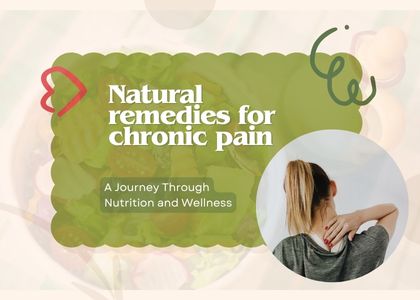Living with chronic pain isn’t easy. It affects your body, your mind, and your daily life. Whether you’re in New York or anywhere in the United States, chronic pain can feel like a constant weight. While doctors often prescribe medication to help, many people look for natural ways to ease pain without relying only on pills.
In this blog, we’ll explore natural remedies that can help support your daily life with chronic pain. These options aren’t magic fixes, but they can make your pain more manageable when used consistently.
Understanding Chronic Pain
Chronic pain is pain that lasts longer than three months. It may be caused by an injury, surgery, nerve damage, arthritis, or a health condition like fibromyalgia. Some people deal with pain in their back, joints, neck, or all over the body.
Pain can be sharp, dull, burning, or aching. Sometimes it flares up and other times it lingers quietly. Chronic pain also often affects sleep, mood, and focus.
That’s where natural remedies come in—helping people live better while dealing with pain. For severe pain some people in United States consider alternatives for managing pain.
Why Natural Remedies?
People in New York and across the U.S. are turning to natural pain relief methods for many reasons:
- To avoid side effects of pain medicines
- To reduce the need for strong prescriptions
- To feel more in control of their health
- To improve overall well-being
Natural remedies can work alongside prescribed treatments, giving your body extra support and reducing stress.
1. Heat and Cold Therapy
One of the simplest ways to relieve pain naturally is using heat or cold:
- Heat therapy: Helps relax tight muscles and boost blood flow. Use heating pads, warm showers, or hot water bottles. Great for back pain or sore joints.
- Cold therapy: Reduces inflammation and numbs sharp pain. Use ice packs wrapped in a cloth. Works well for injuries or swelling.
Tip: Try heat in the morning and cold in the evening if your pain varies throughout the day.
2. Gentle Exercise and Movement
When you’re in pain, moving might be the last thing on your mind. But gentle exercise can help:
- Walking – Easy, low-impact, and good for circulation
- Stretching – Keeps muscles flexible and reduces stiffness
- Yoga or tai chi – Calms the body and mind while improving posture
- Water therapy – Takes pressure off joints and supports easy movement
Start slow and listen to your body. A few minutes a day is better than none. Many pain clinics in New York recommend movement as part of a pain care plan.
3. Anti-Inflammatory Foods
What you eat affects how you feel. A natural pain-fighting diet can help reduce inflammation in the body. Focus on:
- Fruits (especially berries)
- Leafy greens (like spinach and kale)
- Fatty fish (like salmon and sardines)
- Nuts and seeds (like almonds and flaxseeds)
- Turmeric – contains curcumin, a natural anti-inflammatory
- Olive oil – better than processed vegetable oils
Avoid processed foods, added sugar, and fried items, which can make pain worse.
Tip: Keep a food journal to track what helps or worsens your pain.
4. Herbal Supplements and Remedies
Some herbs and natural supplements may help ease chronic pain. Always check with your doctor before starting any supplement.
- Turmeric (curcumin) – fights inflammation naturally
- Ginger – useful for joint and muscle pain
- Boswellia – used for arthritis and swelling
- Magnesium – helps with muscle relaxation and nerve pain
- Capsaicin cream – made from chili peppers, reduces nerve pain when used topically
5. Mind-Body Techniques
Your brain and body are deeply connected. These mental tools can lower stress and change how your brain processes pain.
- Deep breathing – Calms your body and reduces pain flare-ups
- Meditation – Helps manage pain by training your focus
- Mindfulness – Keeps your attention on the present moment, not the pain
- Guided imagery – Uses mental pictures to create calm and ease tension
- Progressive muscle relaxation – Helps you release stress and tightness
Apps like Calm, Headspace, and Insight Timer are popular across the U.S. for practicing mindfulness at home.
6. Acupuncture and Massage Therapy
Acupuncture:
This is an ancient Chinese practice where thin needles are inserted into the skin at certain points. It may:
- Reduce pain
- Improve energy flow
- Help with muscle and nerve issues
Many people in New York City find relief with acupuncture from licensed professionals.
Massage Therapy:
Gentle massage can:
- Improve circulation
- Relax sore muscles
- Lower stress hormones
- Reduce stiffness in joints
Tip: Look for massage therapists who specialize in chronic pain .
7. Good Sleep Habits
Pain makes it hard to sleep, and poor sleep makes pain worse. Improving your sleep can help reduce pain over time.
Try these tips:
- Stick to a regular bedtime
- Avoid caffeine or screens late at night
- Use a supportive mattress and pillow
- Take a warm bath before bed
- Use white noise machines if sounds disturb you
If sleep remains a problem, talk to your doctor. Many people with chronic pain benefit from sleep-focused therapy or medication support.
8. Support Groups and Talking to Others
You are not alone. In fact, over 50 million Americans live with chronic pain. Joining a support group—online or in person—can:
- Help you feel understood
- Give you new tips from others living with pain
- Provide mental relief through connection
Look for groups on Facebook, Reddit, or local health centers in New York. Some hospitals also offer group therapy or pain workshops.
9. Keeping a Pain Journal
A pain journal helps you track what works and what doesn’t. It can include:
- Where the pain is
- When it started
- What you ate
- Activities you did
- How you felt emotionally
- What helped relieve the pain
Doctors and therapists often use this tool to better treat chronic pain.
10. Creating a Pain-Friendly Lifestyle at Home
Make small changes in your environment to better manage daily tasks:
- Use chairs with back support
- Keep hot packs and body pillows nearby
- Use tools to help open jars, reach high shelves, or reduce strain
- Create a quiet corner for rest or meditation
Living with chronic pain isn’t just about medication—it’s about building a life that supports healing.
Final Thoughts
Natural remedies won’t make chronic pain disappear overnight. But when used daily, they can reduce pain levels, improve your mood, and help you enjoy life more.
If you’re in New York or elsewhere in the United States, you have access to many of these resources—from wellness centers to healthy food stores and licensed practitioners.



